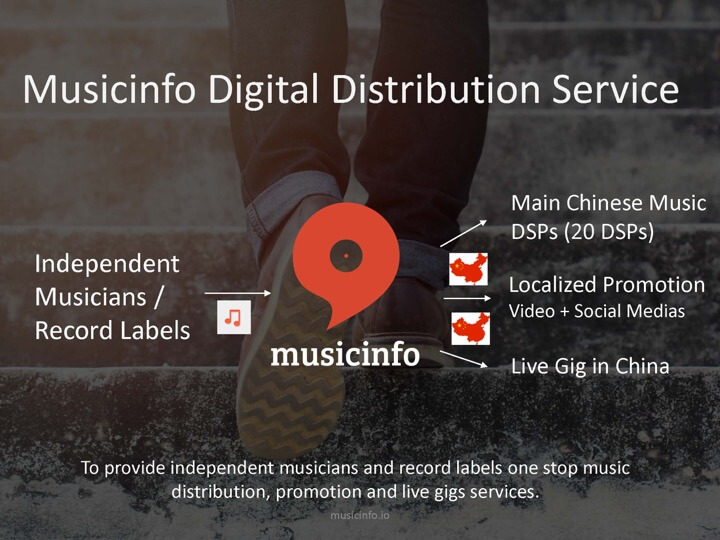You know the phrase “We’re BIG in Japan.” It’s always been an inside joke that Western artists can kind of blow up in Japan, but you never really hear the same about China. That’s odd.
There are 1.4 BILLION people in China, and according to a 2017 study from Nielsen, “more than 977 million people in China – 72% of the population – listen to music every week with 57% of affluent fans attending concerts, compared to 51% in the U.S. Further, whereas hip-hop is the dominant genre in the U.S., affluent fans in China prefer Western or English-language music, and are more likely to listen to pop, rock and jazz.”
Most of those Western artists are major label acts, and it has been next to impossible to get digital distribution as an independent act. Enter Finland-based Musicinfo, a company looking to change that.
I had a fantastic chat with Juri Kobayashi, Marketing Communications for Musicinfo. I didn’t travel to Finland, but judging from my T-Mobile bill for the call, I should have.

Tell me a little about yourself, are you a musician, or just music lover? How did you end up in the music business?
I am a musician. My main instrument is classical guitar. I grew up taking proper lessons, my father was my first teacher. I went to conservatory, I studied at Polytechnic in Finland and then got into the Music, Mind, and Technology program at university and that is what eventually led me to work for Musicinfo.
Give us the Musicinfo “elevator pitch.” What is the company focused on trying to solve?
Until now, Western independent music was non-existent in China. We’re focused on bringing independent labels and artists to over 750 million listeners in China.
I know Musicinfo started as a metadata database; is that still an area the business is focused on?
The company had its start in metadata as a search engine pairing data points of music rights and did a lot of work in China, which has led us to be accepted as a partner there, while based in Finland. But, we have now made the full move to distribution and servicing for labels and artists.
What should an independent artist know about the Chinese market? For instance, is there a dominant genre, do they like instrumentals, etc.?
China is kind of a closed culture, but the youth are very much a part of a huge movement to bring in new flavors, new sounds, and those are often in English. So, there are some stereotypes that hold true, like K-Pop and pop music are the dominant genre. But the good news is that nowadays, 3 out of 5 artists are independent artists in China. Not as much of a major label stranglehold there.
How does an independent artist breakthrough in a foreign country? Do they listen to English music?
English lyrics are fine, it’s the music that people listen to. English is kind of the dominant world language and many in China – much like Africa and Spanish-speaking countries – use entertainment to learn English and music is a big part of that.

How important is it to use your promotion campaigns – (localization content on Tencent, and Weibo etc.)? Is that how most artists are being found?
It is. By using the promotion campaigns, listeners can find out who you are and what your music is about in their native language. We do all of the posting and localization. As with anything creative, the story matters. Having a video is one of the best ways to promote yourself. The video is used quite a bit among Chinese listeners.
One of our independent artists has seen this firsthand; his video has been viewed 3 million times, and his followers are on multiple streaming services.
What are some of the challenges you are finding in China distribution – the laws governing how streaming royalties are counted, mechanicals, currency, etc.? Explicit lyrics, censorship?
The royalties are collected quarterly, and then cashed out in your own currency. Users have the option to download a limited number of tracks as part of their subscriptions, so there are no extra profits there. In the Chinese market, the royalties are paid per streams, not by an aggregate pool. The rates are still low, but volume can make up for that. Censorship is still a thing in China. Explicit lyrics can be an issue, so use clean versions.
What does the future hold for Chinese streamers?
There are over 20 streamers in China, but QQ Music is the leader. Last year, we advertised to an audience of 540 million, now it’s 720 million, might be over 800 million by the end of this year. Also, China is a population that has the greatest number of mobile phones per capita.
So, check out musicinfo.io and definitely do the social promotion package with video.
Prices start at roughly $39 for setup and $12/year for one album. Keep in mind, you keep 100% of the royalties. One album can include up to 30 tracks on most services, so I would also suggest you load the instrumentals of your songs as well for the best chance.
Here’s hoping you go “BIG” in China.
ABOUT THE AUTHOR
–Michael St. James is the founder and creative director of St. James Media, specializing in music licensing, publishing, production and artist development.
